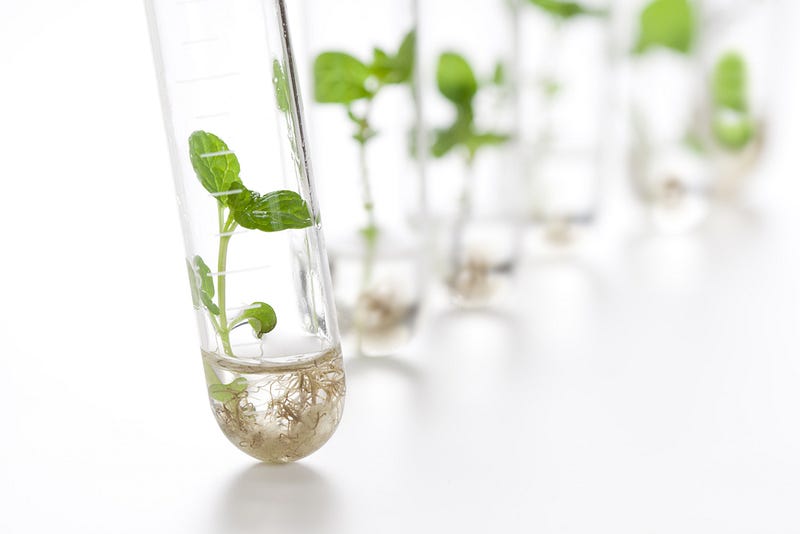Innovative Lab Techniques for Sustainable Biofuel Production
Written on
Chapter 1: Understanding Lab-Grown Plant Material
Plant-based alternatives to fossil fuels are frequently touted as viable renewable resources. However, while they present numerous benefits, they also come with certain drawbacks. One notable issue is deforestation; from 1990 to 2016, over 1.3 million km² (or 500,000 square miles) of forests were cleared, primarily for timber and agricultural expansion. This area is approximately 2.5 times larger than France! Such actions lead to increased CO2 emissions and threaten biodiversity, as seen in the consequences of Amazon rainforest deforestation for sugarcane cultivation aimed at biofuel production, which raises concerns about sustainability.
Moreover, the current supply chain for biofuels derived from plants is plagued by inefficiencies. Often, entire plants are cultivated, yet only a fraction (between 2% and 33%) is utilized, leaving substantial waste. The cultivation process consumes significant resources, including land, water, fertilizers, and pesticides, and transportation of the biomass adds further resource strain.
An alternative approach involves cultivating microalgae for biofuels. For further information, refer to the discussion on how microalgae can serve as a sustainable substitute for fossil fuels. Another promising solution is lab-based plant cultivation, which offers several advantages for biofuel production:
- Large-scale cultivation of plant materials is more feasible.
- Minimal land is required for growth.
- Year-round cultivation is possible, as environmental conditions can be regulated.
- Only necessary plant components can be grown, minimizing waste.
- The properties of plant materials can be adjusted and controlled.
- Various plant cell types, or even whole plants, can be cultivated.
- The resulting biomass is easier to process.
Currently, lab-grown plant materials can be achieved through gel-mediated cell culture, where cells grow in a nutrient-rich gel scaffold that supports three-dimensional growth. Here’s a brief overview of the process:

Media Preparation
The initial step involves preparing the growth media by mixing the necessary ingredients with deionized water to eliminate ions and impurities that could affect cell growth. Sterilization of this solution is vital to remove any bacteria or microorganisms that could disrupt cell development. Additionally, the pH level is adjusted to create the optimal growth conditions, and a synthetic substance is incorporated to stimulate cell division.
Cell Isolation
The next phase is isolating plant cells intended for multiplication. For instance, when isolating leaf cells, they must first be sterilized, rinsed, and cut into strips before being ground into fine particles. The resulting solution, containing the plant cells, is then filtered to remove larger debris and centrifuged to ensure only the desired cell suspension remains.
Cultivating Plant Tissue
In this stage, the isolated cells are placed in wells and maintained in an orbital shaker under dark conditions for two days, supplemented with hormones to encourage growth. The following video illustrates an orbital shaker in action:
After two days, the cells are transferred to a nutrient-rich liquid where they can continue to grow, supported by 3D scaffolds created with a 3D printer. Over several weeks, these individual cells aggregate into plant tissue, and by fine-tuning biochemical and mechanical parameters, the correct cell types and structures can be generated, ultimately leading to biofuel production.
Conclusion
In summary, lab-grown plant tissue can be effectively produced through careful media preparation, cell isolation, and controlled cultivation conditions.
How We Can Contribute
Here are some actionable steps we can take to promote biofuel utilization:
- Opt for diesel blends that include biodiesel when available.
- Use biofuels for vehicle operation instead of fossil fuels whenever possible.
- Substitute biofuel for diesel in lubricating engines.
- Advocate for policies that support sustainable biofuel production.
- Employ biofuels in place of toxic chemicals for tasks like paint and adhesive removal.
If you have additional suggestions on how we can support biofuel initiatives, please share your thoughts in the comments!
Chapter 2: Educational Insights on Algal Biofuels
The first video titled "Basics2Breakthroughs: Genetically improving sorghum for biofuels" delves into how advancements in genetic engineering can enhance sorghum for biofuel applications, potentially offering more efficient resources for biofuel production.
Furthermore, the second video, "KU students grow algae for biofuel, cleaner water," showcases student initiatives to cultivate algae, which serve dual purposes: creating biofuel and promoting cleaner water systems.